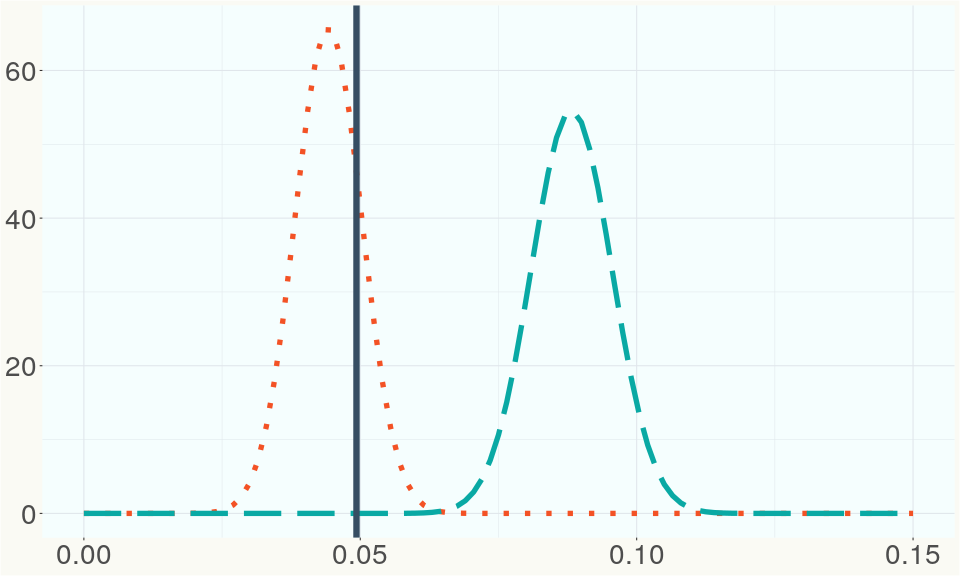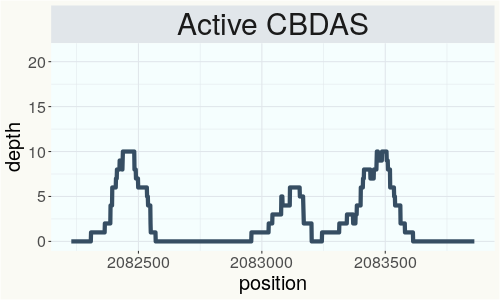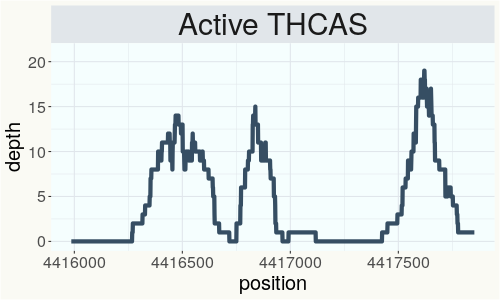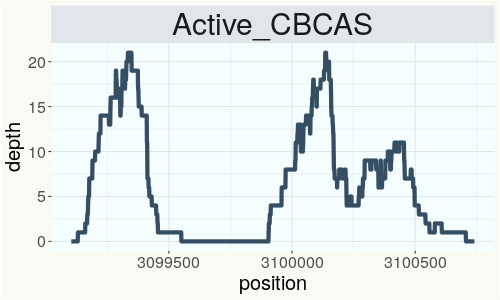CST
RSP 11002
Grower: DigiPath Labs
General Information
- Sample Name
- F20170120-01-12
- Accession Date
- August 28, 2017
- Reported Plant Sex
- Female
- Report Type
- StrainSEEK v2 3.2Mb
- DNA Extracted From
- Unknown
The strain rarity visualization shows how distant the strain is from the other cultivars in the Kannapedia database. The y-axis represents genetic distance, getting farther as you go up. The width of the visualization at any position along the y-axis shows how many strains there are in the database at that genetic distance. So, a common strain will have a more bottom-heavy shape, while uncommon and rare cultivars will have a visualization that is generally shifted towards the top.
Chemical Information
Cannabinoid and terpenoid information provided by the grower.
Cannabinoids
- THC + THCA
- 14.3%
- CBD + CBDA
- 9.678%
- THCV + THCVA
- 0.014%
- CBC + CBCA
- 0.023%
- CBG + CBGA
- 0.252%
- CBN + CBNA
- 0.065%
Terpenoids
- α-Bisabolol
- 0.%
- Borneol
- n/a
- Camphene
- 0.005%
- Carene
- 0.038%
- Caryophyllene oxide
- 0.%
- β-Caryophyllene
- 0.044%
- Fenchol
- n/a
- Geraniol
- 0.%
- α-Humulene
- 0.06%
- Limonene
- 0.047%
- Linalool
- 0.02%
- Myrcene
- 0.229%
- α-Phellandrene
- n/a
- Terpinolene
- 0.215%
- α-Terpineol
- n/a
- α-Terpinene
- 0.021%
- γ-Terpinene
- 0.312%
- Total Nerolidol
- 0.004%
- Total Ocimene
- 0.089%
- α-Pinene
- 0.308%
- β-Pinene
- 0.178%
Genetic Information
- Plant Type
- Type II
File Downloads
The bell curve in the heterozygosity visualization shows the distribution of heterozygosity levels for cannabis cultivars in the Kannapedia database. The green line shows where this particular strain fits within the distribution. Heterozygosity is associated with heterosis (aka hybrid vigor) but also leads to the production of more variable offspring. When plants have two genetically different parents, heterozygosity levels will be higher than if it has been inbred or backcrossed repeatedly.
The ratio of reads mapped to Y-contigs to reads mapped to the whole Cannabis genome (Y-ratios) has been demonstrated to be strongly correlated with plant sex typing. This plot shows the distribution of Y-ratios for all samples in our database which were sequenced with the same method (panel or WGS) as this sample and where this sample falls in the distribution.

This chart represents the Illumina sequence coverage over the Bt/Bd allele. These are the three regions in the cannabis genome that impact THCA, CBDA, CBGA production. Coverage over the Active CBDAS gene is highly correlated with Type II and Type III plants as described by Etienne de Meijer. Coverage over the THCA gene is highly correlated with Type I and Type II plants but is anti-correlated with Type III plants. Type I plants require coverage over the inactive CBDA loci and no coverage over the Active CBDA gene. Lack of coverage over the Active CBDA and Active THCA allele are presumed to be Type IV plants (CBGA dominant). While deletions of entire THCAS and CBDAS genes are the most common Bt:Bd alleles observed, it is possible to have plants with these genes where functional expression of the enzyme is disrupted by deactivating point mutations (Kojoma et al. 2006).



This chart represents the Illumina sequence coverage over the CBCA synthase gene.

Variants (THCAS, CBDAS, and CBCAS)
Variants (Select Genes of Interest)
| PKSG-2a | c.67T>A | p.Phe23Ile | missense variant | moderate | contig700 | 1945567 | A/T | |
| PKSG-2a | c.31A>T | p.Thr11Ser | missense variant | moderate | contig700 | 1945603 | T/A | |
| PKSG-4b | c.496A>G | p.Lys166Glu | missense variant | moderate | contig700 | 2721177 | T/C | |
| PKSG-4b | c.489delT | p.Phe163fs | frameshift variant | high | contig700 | 2721183 | CA/C | |
| PKSG-4b | c.485A>G | p.Lys162Arg | missense variant | moderate | contig700 | 2721188 | T/C | |
| PKSG-4b | c.431T>G | p.Val144Gly | missense variant | moderate | contig700 | 2721242 | A/C | |
| PKSG-4b | c.419A>G | p.Asp140Gly | missense variant | moderate | contig700 | 2721254 | T/C | |
| aPT1 | c.406A>G | p.Ile136Val | missense variant | moderate | contig121 | 2839605 | A/G |
Nearest genetic relatives (All Samples)
- 0.010 Sour Tsunami (RSP11187)
- 0.187 Blue Dream (RSP11008)
- 0.190 Blue Dream (RSP11010)
- 0.193 Blue Dream (RSP11007)
- 0.193 Durban Poison #1 (RSP11013)
- 0.196 Durban Poison #1 (RSP10996)
- 0.197 Blue Dream (RSP11342)
- 0.200 Snoops Dream (RSP11003)
- 0.200 Blue Dream (RSP11004)
- 0.203 Snoops Dream (RSP11031)
- 0.204 Blue Dream (RSP11033)
- 0.207 Electra (RSP11366)
- 0.208 Blue Dream (RSP11006)
- 0.208 Lift (RSP11378)
- 0.209 Super Blue Dream (RSP11011)
- 0.210 Blue Dream (RSP11009)
- 0.211 Durban Poison (RSP11014)
- 0.212 Blue Dream (RSP11032)
- 0.212 Black Jack (RSP10603)
- 0.213 Blue Dream (RSP11005)
Most genetically distant strains (All Samples)
- 0.435 Cherry Blossom (RSP11323)
- 0.431 Cherry Blossom (RSP11318)
- 0.427 Cherry Blossom (RSP11328)
- 0.421 Cherry Blossom (RSP11333)
- 0.420 Cherry Blossom (RSP11314)
- 0.412 Cherry Blossom (RSP11311)
- 0.411 Cherry Blossom (RSP11317)
- 0.408 Red Eye OG (RSP11190)
- 0.406 80E (RSP11213)
- 0.402 Cherry Blossom (RSP11312)
- 0.402 CS (RSP11208)
- 0.392 Cherry Blossom (RSP11309)
- 0.388 Cherry Blossom (RSP11335)
- 0.388 80E (RSP11212)
- 0.386 Cherry Blossom (RSP11308)
- 0.384 Cherry Blossom (RSP11334)
- 0.383 Cherry Blossom (RSP11302)
- 0.382 Cherry Blossom (RSP11324)
- 0.379 East side OG (RSP12089)
- 0.378 Carmaleonte (RSP11207)
Nearest genetic relative in Phylos dataset
- Overlapping SNPs:
- 79
- Concordance:
- 54
Nearest genetic relative in Lynch dataset
- Overlapping SNPs:
- 5
- Concordance:
- 5
Blockchain Registration Information
- Transaction ID
-
3af7f4c0e763b00d
28ae9fd08ece580d a83f0342d5ed2088 8d4778d4e5a2a0e7 - Stamping Certificate
- Download PDF (858.1 KB)
- SHASUM Hash
-
e4823b31bb90d2b282d511f1e22507f4 26d3b921dc20aecb 92385ff7f6ab1d4e